Cryptographic hash functions are used for message authentication, digital signatures, and other applications. They take a variable-length input and produce a fixed-length output. Secure Hash Algorithm (SHA) is a cryptographic hash function designed by the National Institute of Standards and Technology. SHA-1 produces a 160-bit hash. SHA-2 includes SHA-256, SHA-384, and SHA-512, which produce hashes of 256, 384, and 512 bits respectively. SHA-512 processes the message in 1024-bit blocks through 80 rounds, updating buffer values in each round using a 64-bit value derived from the block and an additive constant.

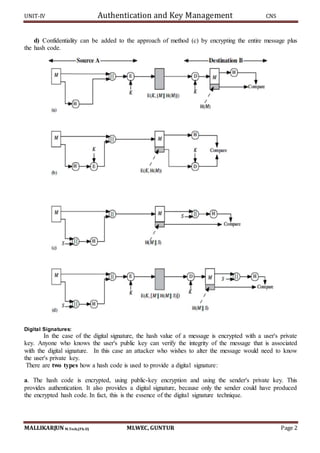
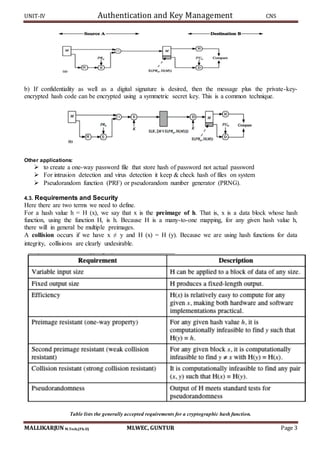

![UNIT-IV Authentication and Key Management CNS
MALLIKARJUN M.Tech,(Ph.D) MLWEC, GUNTUR Page 5
SHA-512 LOGIC:
The algorithm takes as input a message with a maximum length of less than 2128 bits and produces
as output a 512-bit message digest. The input is processed in 1024-bit blocks.
The processing consists of the following steps:
Step 1: Append padding bits, the message is padded so that its length is congruent to 896 modulo 1024
[length = 896(mod 1024)]. Padding is always added, even if the message is already of the desired length.
Thus, the number of padding bits is in the range of 1 to 1024. The padding consists of a single 1 bit
followed by the necessary number of 0 bits.
Step 2: Append length. A block of 128 bits is appended to the message.
Step 3: Initialize hash buffer, A 512-bit buffer is used to hold intermediate and final results of the hash
function. The buffer can be represented as eight 64-bit registers (a, b, c, d, e, f, g, h).
Step 4: Process the message in 1024-bit (128-word) blocks, which forms the heart of the algorithm.
This contains 80 rounds.
Each round takes the input from the buffer value and updates the contents of the buffer.
In first round the buffers has the value of intermediate hash value.
Each round makes use of a 64-bit value Wt derived from the current 1024 bit block being
processed.
In each round an additive constant Ki is used. The constants provide a randomized set of 64-bit
patterns. These constants are predefined.
The output of the eighth round is added to the input of the first round to produce Hi.
SHA-512 PROCESSING OF SINGLE 1024-BIT BLOCK](https://image.slidesharecdn.com/cnsunit-4-190914051000/85/Cryptography-and-netwrk-securityunit-4-5-320.jpg)

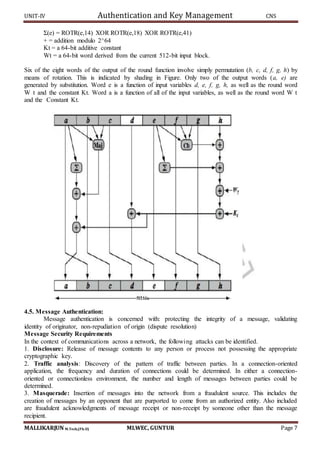



![UNIT-IV Authentication and Key Management CNS
MALLIKARJUN M.Tech,(Ph.D) MLWEC, GUNTUR Page 11
Figure illustrates the overall operation of HMAC:
HMACK = Hash[(K+ XOR opad) || Hash[(K+ XOR ipad) || M)]
where: K+ is K padded with zeros on the left so that the result is b bits in length
ipad is a pad value of 36 hex repeated to fill block
opad is a pad value of 5C hex repeated to fill block
M is the message input to HMAC (including the padding specified in the embedded hash
function) Note that the XOR with ipad results in flipping one-half of the bits of K. Similarly, the
XOR with opad results in flipping one-half of the bits of K, but a different set of bits.
In effect, pseudorandomly generated two keys from K. HMAC should execute in approximately
the same time as the embedded hash function for long messages. HMAC adds three executions of
the hash compression function (for Si, So, and the block produced from the inner hash).
A more efficient implementation is possible by pre-computing the internal hash function on (K+
XOR opad) and (K+ XOR ipad) and inserting the results into the hash processing at start & end.
With this implementation, only one additional instance of the compression function is added to
the processing normally produced by the hash function. This is especially worthwhile if most of
the messages for which a MAC is computed are short.
4.8. CMAC:
The Data Authentication Algorithm cipher-based MAC has been widely adopted in government
and industry. Has been shown to be secure, with the following restriction.
Only messages of one fixed length of mn bits are processed, where n is the cipher block size and
m is a fixed positive integer.
This limitation can be overcome using multiple keys, which can be derived from a single key.
This refinement has been adopted by NIST as the cipher-based message authentication code
(CMAC) mode of operation, for use with AES and triple DES. It is specified in NIST Special
Publication 800-38B.
CMAC Overview:
It uses the block size of the underlying cipher (ie 128-bits for AES or 64-bits for triple-DES). The
message is divided into n blocks M1…Mn, padded if necessary.](https://image.slidesharecdn.com/cnsunit-4-190914051000/85/Cryptography-and-netwrk-securityunit-4-11-320.jpg)
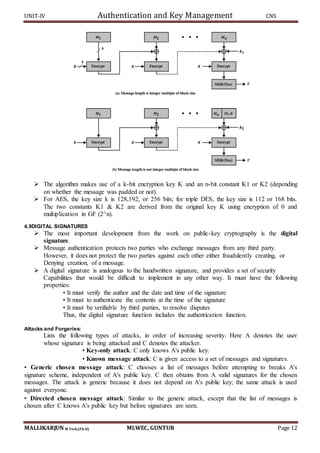
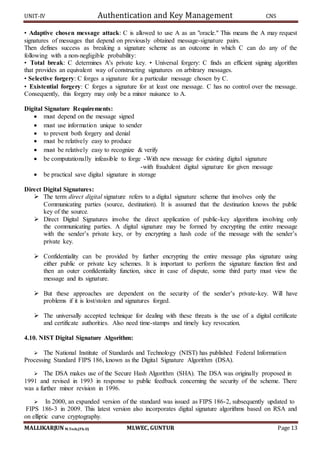
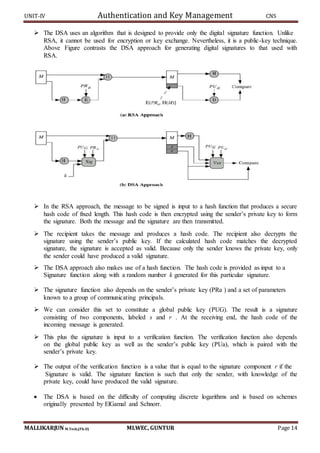

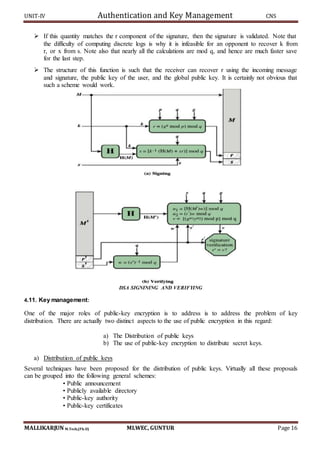


![UNIT-IV Authentication and Key Management CNS
MALLIKARJUN M.Tech,(Ph.D) MLWEC, GUNTUR Page 19
Public Key Certificates:
An alternative approach, first suggested by Kohnfelder [KOHN78], is to use certificates that can
be used by participants to exchange keys without contacting a public-key authority, in a way that is as
reliable as if the keys were obtained directly from a public-key authority.
In essence, a certificate consists of a public key, an identifier of the key owner, and the whole
block signed by a trusted third party. Typically, the third party is a certificate authority, such as a
government agency or a financial institution that is trusted by the user community. A user can present his
or her public key to the authority in a secure manner and obtain a certificate. The user can then publish
the certificate. Anyone needing this user’s public key can obtain the certificate and verify that it is valid
by way of the attached trusted signature.
A participant can also convey its key information to another by transmitting its certificate. Other
participants can verify that the certificate was created by the authority. We can place the following
requirements on this scheme:
1. Any participant can read a certificate to determine the name and public key of the certificate’s owner.
2. Any participant can verify that the certificate originated from the certificate authority and is not
counterfeit.
3. Only the certificate authority can create and update certificates.
These requirements are satisfied by the original proposal in [KOHN78]. Denning [DENN83] added the
following additional requirement:
4. Any participant can verify the currency of the certificate.
A certificate scheme is illustrated in following Figure. Each participant applies to the certificate
authority, supplying a public key and requesting a certificate.
Exchange of public key certificates](https://image.slidesharecdn.com/cnsunit-4-190914051000/85/Cryptography-and-netwrk-securityunit-4-19-320.jpg)